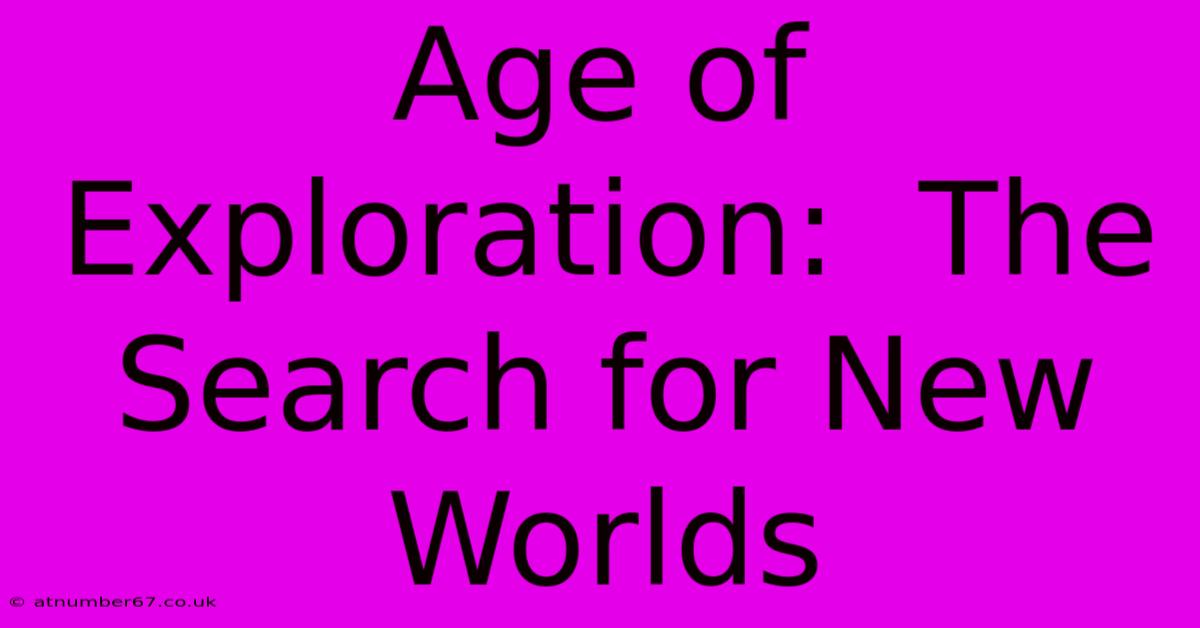Age Of Exploration: The Search For New Worlds

Table of Contents
Age of Exploration: The Search for New Worlds
The Age of Exploration, spanning roughly from the 15th to the 17th centuries, represents a pivotal period in human history. Driven by a complex interplay of factors – economic ambition, technological advancements, and a thirst for knowledge – European powers embarked on voyages of discovery that reshaped the global landscape, forever altering the course of civilizations. This era, often romanticized, was also characterized by brutality, exploitation, and the devastating impact on indigenous populations. Understanding this complex legacy is crucial to grasping its profound influence on the modern world.
The Driving Forces Behind Exploration
Several key factors fueled the Age of Exploration. Economic incentives were paramount. European nations sought new trade routes to the East, bypassing the established, and often expensive, land routes controlled by the Ottoman Empire. The desire for spices, silks, and other luxury goods from Asia drove intense competition between nations.
Technological Advancements: Enabling the Voyages
Technological innovation played a crucial role. The development of the caravel, a sturdy and maneuverable ship capable of long voyages, was instrumental. Improvements in navigation, such as the astrolabe and later the magnetic compass, allowed sailors to chart their course more accurately. Cartography also saw significant advancements, with the creation of more detailed and accurate maps.
Religious and Scientific Zeal: Beyond the Economic
Beyond economic gain, religious zeal and scientific curiosity also spurred exploration. The desire to spread Christianity to new lands was a significant motivator for many expeditions. Simultaneously, the Scientific Revolution fostered a spirit of inquiry and a desire to understand the world beyond Europe's borders. Exploration became a means to expand knowledge and test scientific theories.
Key Explorers and Their Impact
Several individuals stand out as pivotal figures in the Age of Exploration. Christopher Columbus, though his legacy is now viewed with far greater complexity given his brutal treatment of indigenous populations, inadvertently opened up the Americas to European colonization. Vasco da Gama, by sailing around the Cape of Good Hope, established a sea route to India, revolutionizing trade. Ferdinand Magellan, though he perished during his voyage, led the first expedition to circumnavigate the globe. These explorers, along with many others, left an indelible mark on the world map and the course of history.
The Columbian Exchange: A Double-Edged Sword
The Age of Exploration resulted in the Columbian Exchange, a vast transfer of plants, animals, and diseases between the Old World (Europe, Asia, and Africa) and the New World (the Americas). While this exchange introduced new crops like potatoes and tomatoes to Europe, and horses and cattle to the Americas, it also had devastating consequences. The introduction of European diseases like smallpox, measles, and influenza decimated indigenous populations, who lacked immunity.
The Legacy of Exploration: A Complex Inheritance
The Age of Exploration's legacy is complex and multifaceted. While it led to increased global trade and the exchange of ideas and goods, it also resulted in colonialism, exploitation, and the transatlantic slave trade. The impact on indigenous populations was catastrophic, with many cultures destroyed and their lands seized. Understanding this complex legacy requires acknowledging both the positive and negative aspects of this transformative period in human history.
Re-evaluating the Narrative: A Modern Perspective
Modern scholarship increasingly focuses on a more nuanced and critical understanding of the Age of Exploration, moving beyond simplistic narratives of heroic discovery. It emphasizes the perspective of the indigenous populations who suffered greatly under European colonization, and it challenges the traditional Eurocentric viewpoint that often overlooks the contributions of other cultures to the exploration and development of the globalized world.
In conclusion, the Age of Exploration was a period of immense transformation, driven by a combination of economic ambition, technological innovation, and a thirst for knowledge. While it brought about significant advancements in navigation, trade, and global interconnectedness, its impact was profoundly shaped by colonialism, exploitation, and the devastation inflicted upon indigenous populations. A complete understanding of this era requires a critical examination of its multifaceted legacy, acknowledging both its achievements and its devastating consequences.

Thank you for visiting our website wich cover about Age Of Exploration: The Search For New Worlds. We hope the information provided has been useful to you. Feel free to contact us if you have any questions or need further assistance. See you next time and dont miss to bookmark.
Featured Posts
-
Paul Mersons Son Leaving The Legacy Behind
Apr 12, 2025
-
How Much Is Dangote Worth In Naira Really
Apr 12, 2025
-
The Prodigal Son A Story Of Healing And Growth
Apr 12, 2025
-
Lamelo Balls Net Worth Whats Next For The Star
Apr 12, 2025
-
Banaz Death Police Investigation Intensifies
Apr 12, 2025
